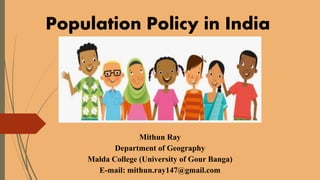
Population Policy in India
- 1. Mithun Ray Department of Geography Malda College (University of Gour Banga) E-mail: mithun.ray147@gmail.com Population Policy in India
- 2. What is Policy! Policy describes what to do and what not Set of ideas or plans that is used as a basis for decision making Attitude and actions of an organisation regarding a particular issue General statement of understanding which guide decision making
- 3. Population Policy Legislative measures, administrative programmes and other government actions in a country intended to regulate population size and its various attributes in the larger interest of the social, political and economic goals. “Measures and programmes designed to the achievement of economic, social, demographic, political and other collective goals through affecting critical demographic variables” [UNO, 1995]
- 5. Population Policy in Pre-Independence Period (Before 1947) Before independence, the Britishers did not consider population growth as a problem Their attitude towards birth control was one of indifference because they never wanted to interfere with the values, beliefs, customs and traditions of Indians. That is why this phase is called the Period of Indifference. The intelligensia in India was aware of the problem of growing population and did advocate birth control. Among them P.K. Wattal was the pioneer who wrote a book on Population Problem in India in 1916, followed by R.D. Karve, Rabindranath Tagore, M.K.Gandhi, P.N. Sapru, Jawaharlal Nehru and Bhore Committee among others who advocated birth control.
- 6. The period following independence and before the beginning of the planning era was one of neutrality. The Government of India was busy with the post-independence problems like rehabilitation of the people following the Partition, reorganisation of the States and Pakistan’s invasion of Kashmir. However, at one of the meetings of the Planning Commission in 1949, Jawaharlal Nehru laid emphasis on the need for family planning programme in India. Period of Neutrality (1947- 1951)
- 7. First Five Year Plan (1951-56) Introduction of Family Planning Allotted 65 lakh
- 8. Second Five Year Plan (1956-61) Emphasis on reducing birth rate To reduce birth rate Clinical Approach was introduced Allotted 5 crore
- 9. Third Five Year Plan (1961-66) Emphasis given on literacy growth to reduce birth rate Health workers were advised to go door to door to make women aware about family planning Allotted 27 crore
- 10. Fourth Five Year Plan (1969-74) Population problems was viewed through socio- economic approach Training of health workers for safety of mothers and childs Allotted 315 crore
- 11. Fifth Five Year Plan(1974-79) National Population policy, 1976 Allotted 700 crore
- 12. National Population Policy 1976 Minimum age of marriage was raised from 15 to 18 years for girls and 18 to 21 years for boys. Emphasis on Women education at least up to middle level Economic assistance for sterilization Modifications of Population Policy 1976 by Janata Sarkar in 1977 • Family Planning Programme was renamed as Family Welfare Programme • Child Marriage Restraint (Amendment) Act, 1978 • Sterilization was made optional • Introduction of population studies in education system
- 13. Sixth Five Year Plan (1980-85) Target Year 2000 to minimise CBR and CDR/ CMR below 21 and 9 respectively
- 14. Seventh Five Year Plan (1986-91) Integration of Family planning with health of both mothers and childs Encouragement to couples to not giving birth more than two childs Child Survival and safe Safe Motherhood Programme was introduced 1.3 lakh primary health centres were established
- 15. Eight Five Year Plan ( 1992-97) Indian population projection Innovations in family planning Integration of population policies along with policies related to women right, poverty alleviation etc. New Child Health Programme 1997
- 16. Ninth Five Year Plan (1997-2002) National Population Policy 2000 (NPP,2000) Target: A. Short Term: To reduce infant mortality rate to below 30 per thousand live births by 2012 To reduce maternal mortality rate to below one per 1000 live births B. Medium Term: To reduce total fertility rate to 2.1 by 2010 C. Long Term: To achieve zero growth rate of population by 2045
- 17. Objectives of NPP 2000 To meet the unfulfilled needs for basic reproductive and child health care services, supplies and infrastructure. To make school education upto age 14 free and compulsory. To achieve universal immunization of children against all vaccine preventablediseases. To promote delayed marriage for girls not earlier than age 18 years of age. To achieve 100 per cent deliveries by trained persons. To make registration of birth, death, marriage and to information for pregnancy compulsory. To curtail spread of AIDS. To achieve universal access8.contraception. To propagate vigorously the benefits of small family norms.
- 18. Strategic Themes of NPP 2000 The National Population Policy has identified the following strategic themes Decentralized planning and programme implementation under which panchayats and other local bodies will plan and implement the family s programme. They will "think, plan and act locally and support nation Expansion of family welfare. Special provisions child health. Empowering women for improved wealth and nutrition. Special family welfare programme for urban slums, tribals and hilly people Use of Indian medicines and homeopathy for family welfare. Research on contraceptive technology. Support for senior citizens. Increasing male participation in family welfare programme.
- 19. Tenth Five Year Plan ( 2002-2007 Janani Suraksha Yojana Neonatal Management initiative Implementation of previous policies
- 20. Eleventh Five Year Plan (2007-2012) To reduce child death rate below 28 per 1000 births by 2012 Maternal Mortality Rate below 1 per 1000 by 2012 Economic encouragement for implementation of NPP 2000
- 21. This Power Point Presentation (PPT) has been prepared especially for Undergraduate Students. The materials (Maps, Diagrams and Images) used in this presentation were collected and compiled mainly from variours academic blogs, research papers, books etc. The author has designed this PPT according to his convenience to deliver the lecture.
- 22. THANK YOU
